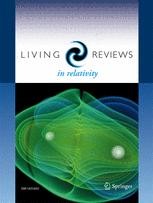Living Reviews in Relativity: "Relativistic fluid dynamics"
 Andersson, N., Comer, G.L. Relativistic fluid dynamics: physics for many different scales. Living Rev Relativ 24, 3 (2021). https://doi.org/10.1007/s41114-021-00031-6
Andersson, N., Comer, G.L. Relativistic fluid dynamics: physics for many different scales. Living Rev Relativ 24, 3 (2021). https://doi.org/10.1007/s41114-021-00031-6
Open Access | Review Article
Published: 24 June 2021
Major update of the 2007 edition.
Abstract:
The relativistic fluid is a highly successful model used to describe the dynamics of many-particle systems moving at high velocities and/or in strong gravity. It takes as input physics from microscopic scales and yields as output predictions of bulk, macroscopic motion. By inverting the process—e.g., drawing on astrophysical observations—an understanding of relativistic features can lead to insight into physics on the microscopic scale. Relativistic fluids have been used to model systems as “small” as colliding heavy ions in laboratory experiments, and as large as the Universe itself, with “intermediate” sized objects like neutron stars being considered along the way. The purpose of this review is to discuss the mathematical and theoretical physics underpinnings of the relativistic (multi-) fluid model. We focus on the variational principle approach championed by Brandon Carter and collaborators, in which a crucial element is to distinguish the momenta that are conjugate to the particle number density currents. This approach differs from the “standard” text-book derivation of the equations of motion from the divergence of the stress-energy tensor in that one explicitly obtains the relativistic Euler equation as an “integrability” condition on the relativistic vorticity. We discuss the conservation laws and the equations of motion in detail, and provide a number of (in our opinion) interesting and relevant applications of the general theory. The formalism provides a foundation for complex models, e.g., including electromagnetism, superfluidity and elasticity—all of which are relevant for state of the art neutron-star modelling.
The authors:
Nils Andersson is a Professor of Applied Mathematics at the University of Southampton, UK. He interested in many problems in general relativistic astrosphysics, in particular related to the dynamics of black holes and neutron stars. His current research is mainly motivated by the promises of gravitational-wave astronomy.
Greg Comer is a professor in the Department of Physics at Saint Louis University, USA. His research interest is the role of multiple fluid dynamics on the creation and emission of gravitational waves from neutron stars.
